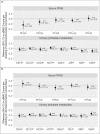Serum PFAS and Urinary Phthalate Biomarker Concentrations and Bone Mineral Density in 12-19 Year Olds: 2011-2016 NHANES
- PMID: 35511700
- PMCID: PMC9282360
- DOI: 10.1210/clinem/dgac228
Serum PFAS and Urinary Phthalate Biomarker Concentrations and Bone Mineral Density in 12-19 Year Olds: 2011-2016 NHANES
Abstract
Context: Per- and polyfluoroalkyl substances (PFAS) and phthalates are 2 families of environmental endocrine disruptors that may be associated with areal lower bone mineral density (aBMD).
Objective: To examine associations between serum PFAS and urinary phthalate biomarker concentrations and their mixtures with aBMD Z-scores in adolescents.
Design, patients, and measures: We examined serial cross-sectional data from male (n = 453) and female (n = 395) 12- to 19-year-old participants in the 2011 through 2016 National Health and Nutrition Examination Survey with measures of serum PFAS, urinary phthalate metabolites, and dual-energy X-ray absorptiometry aBMD Z-scores (total body less head). In sex-specific models, we used linear regression to examine associations of individual PFAS and phthalate biomarkers with aBMD Z-scores, and Bayesian kernel machine regression to examine the association of the overall PFAS/phthalate biomarker mixture with aBMD Z-scores. We replicated the analysis, stratifying by race/ethnicity.
Results: Participants were (mean ± SD) 15 ± 2.1 years of age. In males, each doubling of serum perfluorooctanoate (PFOA), perfluorooctane sulfonate, urinary mono-isobutyl phthalate (MiBP), mono-n-butyl phthalate, and the overall PFAS/phthalate mixture was associated with a lower aBMD Z-score (eg, for PFOA: -0.24; 95% CI, -0.41 to -0.06). Serum PFOA and urinary MiBP were associated with higher aBMD Z-scores in females (eg, for PFOA: 0.09; 95% CI, -0.07 to 0.25). Findings did not differ by race/ethnicity.
Conclusions: Certain PFAS and phthalates may be associated with reduced bone mineral density in adolescent males. Bone mineral density tracks across the life course, so if replicated in longitudinal cohorts, this finding may have implications for lifelong skeletal health.
Keywords: National Health and Nutrition Examination Survey; bone mineral density; children; per- and polyfluoroalkyl substances; phthalates.
© The Author(s) 2022. Published by Oxford University Press on behalf of the Endocrine Society. All rights reserved. For permissions, please e-mail: journals.permissions@oup.com.
Figures


Comment in
-
Bone Accrual During Adolescence: Do Endocrine-Disrupting Chemicals Play a Role?J Clin Endocrinol Metab. 2022 Sep 28;107(10):e4242-e4243. doi: 10.1210/clinem/dgac391. J Clin Endocrinol Metab. 2022. PMID: 35762324 Free PMC article. No abstract available.
Similar articles
-
Associations of Maternal Serum Perfluoroalkyl Substances Concentrations with Early Adolescent Bone Mineral Content and Density: The Health Outcomes and Measures of the Environment (HOME) Study.Environ Health Perspect. 2021 Sep;129(9):97011. doi: 10.1289/EHP9424. Epub 2021 Sep 29. Environ Health Perspect. 2021. PMID: 34585601 Free PMC article.
-
Mid-Childhood Plasma Concentrations of Per- and Polyfluoroalkyl Substances, Modifiable Lifestyle Factors, and Bone Mineral Density Through Late Adolescence.Environ Sci Technol. 2024 Nov 12;58(45):19970-19980. doi: 10.1021/acs.est.4c08480. Epub 2024 Nov 1. Environ Sci Technol. 2024. PMID: 39485370
-
Per- and Polyfluoroalkyl Substance Plasma Concentrations and Bone Mineral Density in Midchildhood: A Cross-Sectional Study (Project Viva, United States).Environ Health Perspect. 2019 Aug;127(8):87006. doi: 10.1289/EHP4918. Epub 2019 Aug 21. Environ Health Perspect. 2019. PMID: 31433236 Free PMC article.
-
Associations of pregnancy phthalate concentrations and their mixture with early adolescent bone mineral content and density: The Health Outcomes and Measures of the Environment (HOME) study.Bone. 2022 Jan;154:116251. doi: 10.1016/j.bone.2021.116251. Epub 2021 Nov 2. Bone. 2022. PMID: 34740813 Free PMC article.
-
Bone mass density following developmental exposures to perfluoroalkyl substances (PFAS): a longitudinal cohort study.Environ Health. 2022 Nov 19;21(1):113. doi: 10.1186/s12940-022-00929-w. Environ Health. 2022. PMID: 36402982 Free PMC article.
Cited by
-
Exposure to perfluoroalkyl substances and longitudinal changes in bone mineral density in adolescents and young adults: A multi-cohort study.Environ Res. 2024 Mar 1;244:117611. doi: 10.1016/j.envres.2023.117611. Epub 2023 Dec 6. Environ Res. 2024. PMID: 38061983 Free PMC article.
-
Bone Accrual During Adolescence: Do Endocrine-Disrupting Chemicals Play a Role?J Clin Endocrinol Metab. 2022 Sep 28;107(10):e4242-e4243. doi: 10.1210/clinem/dgac391. J Clin Endocrinol Metab. 2022. PMID: 35762324 Free PMC article. No abstract available.
-
Exposure to per- and polyfluoroalkyl substances and high-throughput proteomics in Hispanic youth.Environ Int. 2024 Apr;186:108601. doi: 10.1016/j.envint.2024.108601. Epub 2024 Mar 23. Environ Int. 2024. PMID: 38537583 Free PMC article.
-
Per- and polyfluoroalkyl substances and bone mineral content in early adolescence: Modification by diet and physical activity.Environ Res. 2024 Jul 1;252(Pt 1):118872. doi: 10.1016/j.envres.2024.118872. Epub 2024 Apr 3. Environ Res. 2024. PMID: 38580001 Free PMC article.
-
Toxic effects of per- and polyfluoroalkyl substances on sperm: Epidemiological and experimental evidence.Front Endocrinol (Lausanne). 2023 Feb 20;14:1114463. doi: 10.3389/fendo.2023.1114463. eCollection 2023. Front Endocrinol (Lausanne). 2023. PMID: 36891048 Free PMC article. Review.
References
-
- CDC. Centers for Disease Control and Prevention. Fourth National Report on Human Exposure to Environmental Chemicals, Updated Tables, (January 2019). Atlanta, GA: U.S. Department of Health and Human Services, Centers for Disease Control and Prevention. https://www.cdc.gov/exposurereport/
-
- CHAP (Chronic Hazard Advisory Panel on Phthalates and Phthalate Alternatives). Bethesda, MD: U.S. Consumer Product Safety Commission, Directorate for Health Sciences; 2014. Accessed September 4, 2020. https://www.cpsc.gov/s3fs-public/CHAP-REPORT-With-Appendices.pdf

